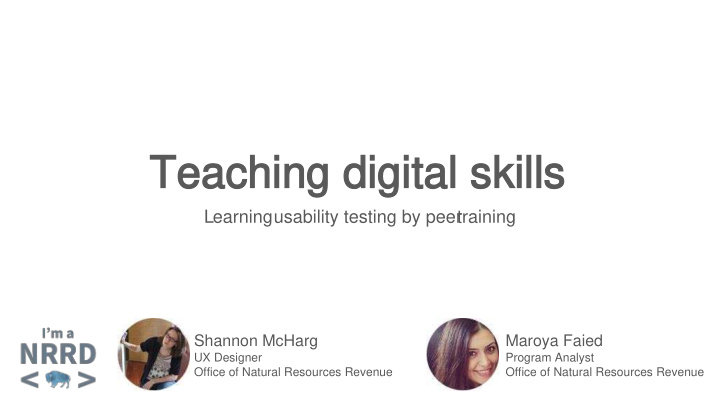



Teaching digital skills Teaching digital skills Learning usability testing by peer training Shannon McHarg Maroya Faied UX Designer Program Analyst Office of Natural Resources Revenue Office of Natural Resources Revenue
Who we are
Who we are | What is the Office of Natural Resources Revenue? For the benefit of all A mericans, ONRR collects, accounts for, and verifies natural resource and energy revenues due to States, A merican Indians, and the U.S. Treasury.
Who we are | What we work on Our team manages an open data website about how the U.S. government manages energy and mineral resources, revenue, and disbursements from federal lands and waters. revenuedata.doi.gov revenuedata.doi.gov
Who we are | Vision statement We are informing policy debates and raising public awareness by building the definitive source of timely and useful data about how the government manages federal energy and mineral resources, revenue, and disbursements.
Who we are | Who uses our site
Who we are | Beginnings of the site The Presidential Innovation Fellow went on to Driven by EITI requirements and their multi - become one of the founders of 18F, so ONRR stakeholder group, ONRR brought in a pitched the project to continue the Presidential Innovation Fellow to conduct development of the site and they accepted it research and create a prototype of the site. as one of their first projects.
Who we are | Team structure Product Manager/Product Owner Jennifer Malcolm Term limited (2 -4 years) innovation specialists Career government employees Developer Content UX Designer Program Analysts Jeff Keene Strategist Shannon Chris Maroya Lindsay McHarg Ryan Johnson Mentasti Faied Goldstein
Who we are | How we got here
Who we are | Our process
Peer training
Peer training | Why we decided to peer train The scope of our site keeps increasing ● Other teamsin our agency are interested in ● user research ● We have a small team with only one, term - limited designer Recruiting participants takes a LOT of time ●
Peer training | Learning by doing We decided that it would be best to learn by doing and do mock interviews.
Which meant…
I had to document all of my processes in detail.
While I did that…
Maroya and Lindsay started by reading about user research to get the basics and hear it from the experts.
Peer training | Usability testing process Planning Conducting the study Analysis • Decide on study goals • Facilitate the sessions • Consolidate findings • Write study plan & • Debrief with observers across participants interview guide after each session • Identify trends and • Recruit participants recommendations • Plan for note taking • Present to the team and post on GitHub • Create issues for anything we decide to fix • Carry any remaining issues to ongoing findings documentation
Peer training | Planning ● The analysts put together a study plan & guideto test a prototype for a new design. ● The two analysts practiced facilitating on each other. ● Then we recruited our teammates to participate as fake participants, mimicking things we’ve seen real users do in previous studies.
Peer training | Study plan
Peer training | Interview guide
Peer training | Planning learnings • Goals of the study • Method & desired participants • Recruiting strategy
Peer training | Conducting the study The analysts took on all of the logistical tasks of the study moderator. ○ Conducting the study ○ Communicating with the participants ○ Troubleshooting technology issues with Google Hangouts ○ Ensuring we had a note-taker ○ Coordinating the post-session debriefs A fter each session, the designer provided feedback on the moderator’s facilitation.
Peer training | Conducting the study learnings • Being Organized • Interacting with participants • Observing actively
Peer training | A nalysis The analysts took on all of the analysis ○ Consolidating findings ○ Identifying trends and recommendations ○ Creating a findings summary and presenting to the team and posting to Github ○ Creating issues for agreed on changes ○ Documenting items for future analysis The designer provided feedback on the analysis.
Peer training | Findings consolidation spreadsheet
Peer training | Findings presentation
Peer training | Findings GitHub summary
Peer training | Analysis learnings • Summarizing findings • Organize findings by scope & severity • Recommending Design solution
Outcomes
“Learning usability testing was both fascinating and eye- opening. The experience of conducting an interview and analyzing the results stimulated my interest to approach future projects by observing problems and finding solutions by considering different perspectives.” Maroya Faied, Program Analyst
Outcomes | Greater team engagement ● User empathy ● More detailed look at prototype ● Cognitive walkthrough
Outcomes | More process documentation
Outcomes | Change in mindset ● Planning time helps the work run smoothly. ● Documentation makes it easier to spot opportunities for process improvement and sharing results. ● Provides a method to incorporate many viewpoints without creating conflict amongst team members or work groups.
Increasing our capacity for user research is helping us build bridges with other teams in our agency who are working on products that could benefit from user feedback. We are helping introduce user-centered design practices to those teams.
Thank you! Questions? Connect with us nrrd@onrr.gov https://revenuedata.doi.gov/blog/ https://github.com/ONRR/ @DOIONRR https://www.facebook.com/DOIONRR/
Photo attribution "Creative Commons Bàrbara's 30th birthday - playtime! 11/11/11" by Jordi Payà, used under CC BY / Turned black and white from original "Creative Commons Learning by doing 2009!" by Photo RNW.org, used under CC BY-ND "Creative Commons Rowing Team at HMSP" by Virginia State Parks, used under CC BY
Recommend
More recommend